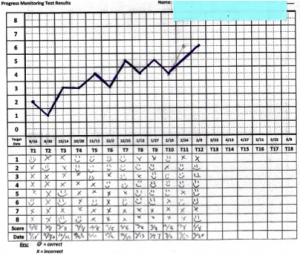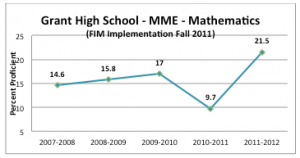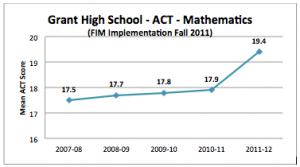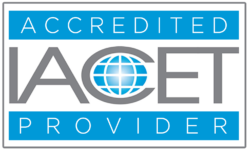“The sun’s rays do not burn until brought to a focus.” – Alexander Graham Bell
Taking an informal walk past the math classrooms at Grant High School might confuse the casual observer. In an Algebra II classroom, students can be overheard discussing geometry problems. In a geometry classroom across the hall, the teacher explains to students that the concepts being previewed that day will not be thoroughly studied until much later in the school year. At first glance, these classrooms might appear disjointed and disorganized. However, teachers are actually presenting the material in a precisely calculated method, following the Focused Instructional Model (FIM). Grant High School is one of many schools that have implemented the FIM and are excited about the growth shown by students.
 The idea of focusing on key concepts is not new to the field of education. Dr. Douglas Reeves coined the term, “Power Standards” and, with Larry Ainsworth, in 2003 published Power Standards: Identifying the Standards that Matter the Most. Dr. Robert Marzano warned about the dangers of attempting to teach a curriculum that is “a mile wide and an inch deep.” Progress monitoring students to provide targeted instruction has also been examined and encouraged by many quality educators within the past few years. The Focused Instructional Model is a research-based method of delivering a focused curriculum that provides time for progress monitoring and remediation. Encouraged by successful results,teachers at many schools across the state are joining Grant High in the implementation of the FIM.
The idea of focusing on key concepts is not new to the field of education. Dr. Douglas Reeves coined the term, “Power Standards” and, with Larry Ainsworth, in 2003 published Power Standards: Identifying the Standards that Matter the Most. Dr. Robert Marzano warned about the dangers of attempting to teach a curriculum that is “a mile wide and an inch deep.” Progress monitoring students to provide targeted instruction has also been examined and encouraged by many quality educators within the past few years. The Focused Instructional Model is a research-based method of delivering a focused curriculum that provides time for progress monitoring and remediation. Encouraged by successful results,teachers at many schools across the state are joining Grant High in the implementation of the FIM.
How exactly is the Focused Instructional Model implemented in classrooms? The first step is to analyze data and choose eight to ten key concepts, or power standards, that students will focus on throughout the entire school year. Item analysis data from MEAP, MME, and ACT results will help with the selection of these key concepts. After the key concepts are chosen, the FIM can be broken down into three major components:
1) Warm-ups: Teachers utilize the first 10 to 20 minutes of classroom instruction time (often used by teachers as “warm-up” time) to present two questions or problems per day that focus on the key concepts as identified by the teachers. For an example, we can look to Grant High School. Math teachers chose eight key concepts. They conduct warm-ups Monday through Thursday each week. On Monday, the first two key concepts are covered (one question from each). On Tuesday, the next two are covered. No matter what unit the students are studying, or what the lesson of the day will be, the cyclical repetition of these key concepts during warm-up time will help preview or review important material throughout the entire school year.
2) Progress Monitoring Tests: Every other Friday, students take Progress Monitoring Tests (PMTs) so they can self-evaluate and the teachers can make sure they are progressing smoothly through the material. On these PMTs, there is one question from each of the key concepts. Early in the school year, students are not expected to get many (if any) questions correct because they have not yet studied the material. As the students progress through the curriculum, their scores will improve. Students chart their own progress by keeping a line graph on which they plot their results every other week. These bi-weekly assessments give teachers focused, relevant, consistent data so they can identify students in need of intervention on a regular basis.
so they can self-evaluate and the teachers can make sure they are progressing smoothly through the material. On these PMTs, there is one question from each of the key concepts. Early in the school year, students are not expected to get many (if any) questions correct because they have not yet studied the material. As the students progress through the curriculum, their scores will improve. Students chart their own progress by keeping a line graph on which they plot their results every other week. These bi-weekly assessments give teachers focused, relevant, consistent data so they can identify students in need of intervention on a regular basis.
3) Intervention/Celebration: Teachers can use the data from the Progress Monitoring Tests to identify students who might be falling behind and are in need of focused intervention. For example, if key concept number one has been thoroughly covered and assessed in class, but a particular student is still consistently getting that problem incorrect on the PMTs, that student can receive intervention focused on that key concept. Schools have different ways to provide this intervention time during school – teachers might share students to present the relevant material to small groups while students who have proven proficiency are rewarded and given a time to celebrate their success.
To summarize, teachers use data to identify key concepts (power standards), cyclically present these concepts throughout the entire school year during warm-up time, assess their students bi-weekly on Progress Monitoring Tests, and provide focused intervention based on the results of these PMTs.
The math department at Grant High School implemented the Focused Instructional Model in the fall of 2011. Math proficiency scores on the MME grew 12% the first year. Additionally, the number of students receiving a 4, which is the lowest possible score, decreased by 15%.

For four years in a row (2007-2010), before the implementation of the FIM, student scores on the math portion of the ACT at Grant were between 17 and 17.9. After only one partial year of implementation, the average math score on the ACT jumped to 19.4.
It is important to note that the Focused Instructional Model can be used in any discipline, not just in math. After seeing the successes in math classrooms, teachers from other core content areas have implemented the FIM. The idea of using classroom warm-up time to repeatedly present key concepts, formatively assess students regularly, and provide intervention when necessary can be duplicated in any discipline. Language Arts teachers are focusing on grammar, reading, and writing, while Social Studies teachers have identified reading maps and timelines as important concepts to cyclically review.
Recently, there have been exciting changes in the field of education. The implementation of the Common Core State Standards lines up perfectly with the Focused Instructional Model. David Coleman and Jason Zimba, two lead writers of the CCSS in ELA and Math, spoke about the importance of implementing a “teach less, learn more” model at the Education Commission of the States’ policy forum in 2011. Their message to educators included urging them to teach truly important skills to mastery level. The Focused Instructional Model is a perfect way to transition into full implementation of the Common Core State Standards. The growth that has taken place at Grant High School shows that the FIM can help teachers and students succeed in the ever-changing field of education.


